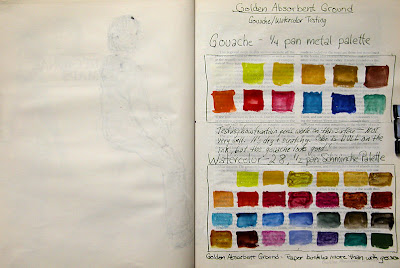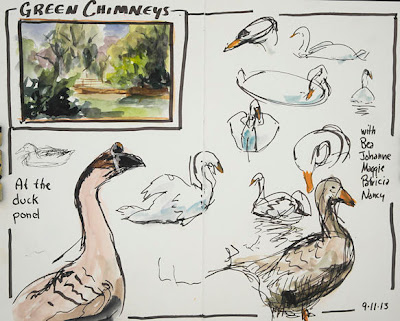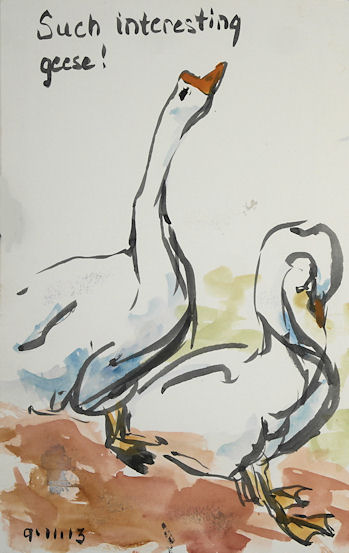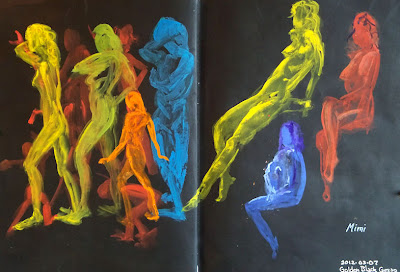Quick boat studies
11x17" across a two page spread in my altered book
Although I prefer to work just in one main art journal at a time, there are sometimes reasons for turning to something else. In this case, I didn't want to burn through a lot of good, expensive paper for quick sketches and experiments. My plan was to use this other book for short poses in life drawing sessions, as well as quick practice sketches of one kind or another that I don't want to put into my art journal. I decided to take an old 8 1/2 x 11" book which still had a good, solid binding, and gesso pages to sketch on. That way it would be very inexpensive, and the gesso would soften the background text or images to increase depth while eliminating the visual distraction or competition with the sketches.The sketch above of the boats was done over one of the maps in the book. I thought it rather appropriate that they were sketched over oceans!
I selected a book with a lot of graphical content, as well as pages of full text. I used Golden Acrylic Gesso, and also tried some pages with Golden Absorbent Ground, as well as a couple with Golden Black Gesso just for fun. I thought the Absorbent Ground might provide a better working surface if I wanted to add any watercolor washes. The sketch above of the boats was done using Pitt Brush Pens on pages coated with the Golden Absorbent Ground. (Just because I liked the idea of doing them on the page spread with the map, and that happened to be prepared that way.)

I tested out my gouache and watercolor palettes to see how the colors would look on the surface of this paper with the Absorbent Ground. Answer: Pretty dull, though in person they have more vibrancy than they do in this digital image. Plus, it wrinkled the paper more than the Golden Acrylic Gesso. Speaking of which, if buckling paper bothers you, an altered book like this is probably not something that would interest you. Even pages coated with gesso did wrinkle. Of course, this paper was designed for printed text, and not for wet media! The gesso does add strength to the paper and gives it some sizing, but at the cost of some wrinkling. I dried each page spread with a hair dryer as I went along, then set it under a very heavy coffee table book overnight to help control some of the wrinkling.
On the left side above, you can see the ink from a sketch on the previous page coming through the paper a bit. That was a blank page, so I didn't coat it with anything on either side. Pages that were sized with either the Golden Acrylic Gesso or the Golden Absorbent Ground did not bleed through, nor show ghosting of images on the reverse side of the pages. (The wrinkling on that left hand page is just from the little bit of watercolor used in that one area of the previous page, and not from applying a sizing.)
Below, the page on the left was sized with the gesso. The page on the right was only sized in one area. I left the more graphical page text that was printed on the right side. I thought I might use it as inspiration for some doodles, and I just kind of liked it! On several of the pages, I left bits of text, titles, or graphical elements without applying gesso over them.
I took the book to life drawing a couple of weeks ago. It was my first time going to an open studio session this winter, and go figure; the model didn't show! Some people from the group took turns doing three minute poses, and then everybody went home. These were a few of the three minute poses I did to test drive the book. I used a Wolff's 6B carbon pencil with a waterbrush, and added some light washes to a couple of the figures.
From time to time, I'll be showing some of my figure work or sketches done in this book, but for the most part, it's for short poses, quick sketches, doodles, border designs that I'm working out, testing ideas for fonts, and other things where I not only don't want to waste high quality paper, but for the most part, it's not even worth taking the time to photograph, adjust and post the images! However, in the interest of exposing other artists to the potential for using old books, I thought it was worth the post. I had initial pangs of guilt about "destroying" a book. But it wasn't too hard for me to convince myself that a book is not a one-of-a-kind work of art. In this age of reusing, repurposing, recycling, and reducing waste, creating sketchbooks from old books feels like a good thing to do. If you are opposed to using a book this way, consider doing it with a phone book or old catalog!















